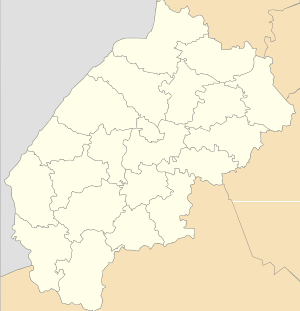Velyki Mosty
| Velyki Mosty Великі Мости | ||
|---|---|---|
| City | ||
| ||
| Country |
| |
| Oblast (province) | Lviv | |
| Raion (district) | Sokal | |
| Population (2013) | ||
| • Total | 6,121 | |

Velyki Mosty (Ukrainian: Великі Мо́сти; Polish: Mosty Wielkie; Hebrew: מוסט רבתי) is a city in Sokal Raion of Lviv Oblast (region) of Western Ukraine. Population: 6,121 (2013 est.)[1].
In the Kingdom of Poland, the village of Mosty was a royal property, with its own starostas. The village itself was established in 1472, and was part of Belz Voivodeship. In the late 15th century, Mosty was ransacked and destroyed in a Crimean Tatars raid, and in July 1497, during the Moldavian expedition of John I Albert, a unit of Teutonic Knights under Johann von Tiefen, called upon by the Polish king, marched through the village. On 23 July 1549, during the period known as the Polish Golden Age, Mosty received Magdeburg rights. Following the order of King Zygmunt August, a nobleman Andrzej Rokicki became the first local wojt. Mosty enjoyed several royal privileges, issued in the years 1550, 1553, 1566, 1576, 1583, 1604. The town also became the seat of a starosta.
Until 1772, Mosty remained in Belz Voivodeship. Following the Partitions of Poland, the town became part of Austrian Galicia. In 1846, a complex of military barracks was built in Mosty, and in 1880, the town had the population of almost 4,000. In the Second Polish Republic, the Central Police Academy was located here. The Jewish population was important in the town.[2] During World War II, Germans occupied the town and kept the Jews prisoners in a ghetto using them as forced labour before murdering them all.[3]
Currently, Mosty has a local branch of the Association of Polish Culture of the Lviv Land. Among people born here are photographer Wlodzimierz Puchalski, mathematician Wlodzimierz Stozek and Austrian painter Siegfried Weyr.
Gallery
 Rata River in Velyki Mosty
Rata River in Velyki Mosty.jpg) Ruins of the former synagogue
Ruins of the former synagogue.jpg) Inside view of the ruins
Inside view of the ruins
References
Coordinates: 50°14′24″N 24°08′22″E / 50.24000°N 24.13944°E
